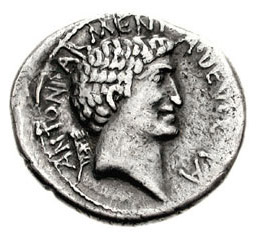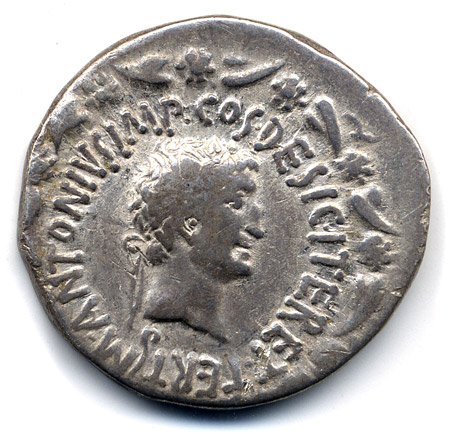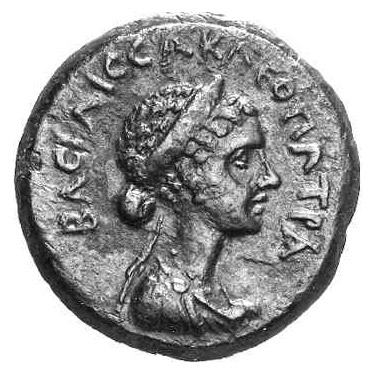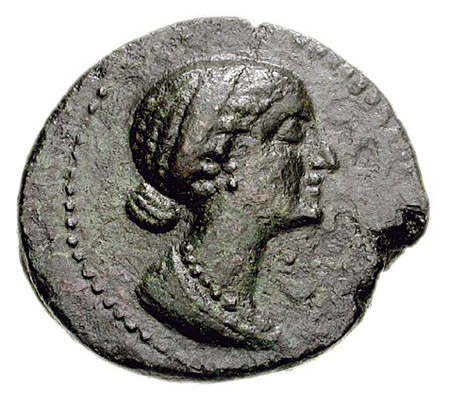Cleopatra and Egypt
Plutarch (Antony 27.2) comments that Cleopatra was not overly beautiful, but that the charm of her presence was irresistible and this, combined with her peculiar force of character, made everyone associated with her fall under her spell.
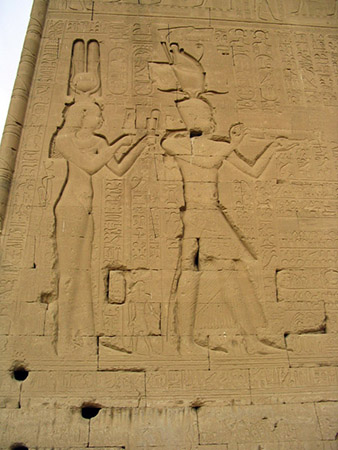
"For her beauty, as we are told, was in itself not altogether incomparable, nor such as to strike those who saw her; but converse with her had an irresistible charm, and her presence, combined with the persuasiveness of her discourse and the character which was somehow diffused about her behaviour towards others, had something stimulating about it." (trans. B. Perrin)
Nusmismatic evidence bears out Plutarch's testimony. On coins Cleopatra is portrayed in a realistic manner with a large, decisive aquiline nose and prominent forehead. The coins of Cleopatra also document her aspirations and the history of her reign (51-30 BC).
Cleopatra, the third daughter of Ptolemy XII Auletes, was born in 69 BC. After her father died in 51 BC, she and her younger brother (Ptolemy XIII) became joint monarchs. During the civil war between Caesar and the Roman Senate (49BC) Cleopatra allied herself with Caesar, famously rolling herself up in a carpet. Caesar made Cleopatra Queen of Egypt in 48 BC. Cleopatra minted coins at Alexandria with her portrait on them (as any ruler had the right to do).
In 41 BC, after Caesar's death, Antony summoned Cleopatra to question her about her loyalty. She and Antony also began an affair that resulted in three children. After Antony's conquest of Armenia in 34 BC the relationship materialised on coinage. Coins (RRC 543/1, 545/1-2) were struck proclaiming Antony's victory, and the relationship between him and Cleopatra. Unlike Caesar, Antony publicly proclaimed his relationship with the Egyptian queen. His portrait appears on one side of the coin, Cleopatra's on the other. (RRC 543/1)
Antony had previously released coinage displaying his head on one side and Octavia's on the other. (RRC 527/1). The marriage between Antony and Octavia had been celebrated and advertised as a symbol of the unity between the triumvirs. Cistophori struck in Asia marked the union between the couple (RPC 2201). By placing Cleopatra on his coins instead of Octavia, Antony visibly distanced himself from Octavia and her brother Octavian. As with the earlier coins of Antony/Octavia, a double portrait is used. However, unlike Octavia and other Roman women, Cleopatra is named and her titles given. This suggests that she appears as a ruler in her own right (Buttrey 1954).
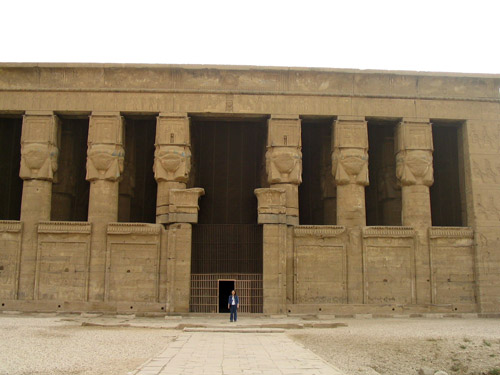
Cleopatra's image also appears on coins of Patras (RPC 1245), a port where Antony wintered before the battle of Actium (32/1 BC). The coin displays the bust of Cleopatra on the obverse, with the crown of Isis on the reverse. Her numismatic presence is a testament to Cleopatra's central role in this period.
Plutarch (Antony 36) records that Antony showered Cleopatra with gifts of territory including Pheonicia, Coele Syria, Cyprus, a large part of Cilicia, part of Judea and the coastal strip of Arabia Nabatea. Recognising their new queen, these cities struck coins with Cleopatra's image. Examples include Orthosia (RPC 1 4501-2), Tripolis (RPC 1 4510), Berytus (RPC 1 4529-30), and Chalcis (RPC 1 4771) among others. Damascus also struck coins with Cleopatra's image (RPC 1 4781, 4783). Though no literary sources state that this city was within her control, the fact that coins were struck with her portrait suggests that Damascus was given to her by Antony along with other territories.

